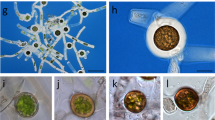Summary
Rapid zygote formation byCosmarium botrytis was induced in a liquid medium by incubation in 5% CO2. Conjugation and zygote formation were studied by SEM, TEM, phase-contrast, and Calcofluor fluorescence microscopy. It was observed that the cells divided immediately prior to conjugation and formed Calcofluor fluorescent conjugation papillae as soon as the primary wall was shed. The conjugating cells and the resultant zygote were envelopped by a non-fluorescent mucilagenous envelope which was eventually pierced by the zygote spines, but never shed. The very young smooth-walled zygote had a thick Calcofluor fluorescent wall. At that stage the zygote could be plasmolysed in 0.4 M mannitol, but no protoplast could be induced to emerge even with the addition of up to 5% Cellulysin; probably indicating that the zygote wall composition and structure is different from that of the secondary wall of the vegetative cells, particularly in the absence of mucilage pores.
Similar content being viewed by others
References
Berliner, M. D., Wenc, K. A., 1976: Protoplast induction inMicrasterias andCosmarium. Protoplasma89, 389–393.
—,Wood, N. L., Damico, J., 1978: Vital and Calcofluor staining ofCosmarium and its protoplasts. Protoplasma96, 39–46.
Brandham, P. E., 1965: Polyploidy in desmids. Canad. J. Bot.43, 405–417.
—,Godward, M. B. E., 1965: The inheritance of mating type in desmids. New Phytol.64, 428–435.
Hughes, J., McCully, M. E., 1975: The use of an optical brightener in the study of plant structure. Stain Technol.50, 319–329.
Lott, J. N. A., Harris, G. P., Turner, C. D., 1972: The cell wall ofCosmarium botrytis. J. Phycol.8, 232–236.
Lyon, T. L., 1969: Scanning electron microscopy: a new approach to theDesmidiaceae. J. Phycol.5, 380–382.
Mix, M., 1966: Licht- und elektronenmikroskopische Untersuchungen an Desmidiaceen. XII. Zur Feinstruktur der ZellwÄnde und Mikrofibrillen einiger Desmidiaceen vomCosmarium-Typ. Arch. Mikrobiol.55, 116–133.
Pickett-Heaps, J. D., 1974: Scanning electron microscopy of some cultured desmids. Trans. Amer. Microscop. Soc.93, 1–23.
Reynolds, E. S., 1963: The use of lead citrate at high pH as an electron-opaque stain in electron microscopy. J. Cell Biol.17, 208–212.
Starr, R. C., 1954: Heterothallism inCosmarium botrytis var.subtumidum. Amer. J. Bot.41, 601–607.
—, 1958: The production and inheritance of the triradiate form inCosmarium turpinii. Amer. J. Bot.45, 243–248.
Spurr, A. R., 1969: A low-viscosity epoxy resin embedding medium for electron microscopy. J. Ultrastruct. Res.26, 31–49.
Ueno, T., Sasaki, K., 1978: Light dependency of the mating process inClosterium acerosum. Plant Cell Physiol.19, 245–252.
Author information
Authors and Affiliations
Rights and permissions
About this article
Cite this article
Berliner, M.D., Guth, E. Zygote formation inCosmarium botrytis studied by scanning and transmission electron microscopy, phase-contrast, and Calcofluor staining. Protoplasma 101, 1–10 (1979). https://doi.org/10.1007/BF01293430
Received:
Accepted:
Issue Date:
DOI: https://doi.org/10.1007/BF01293430




